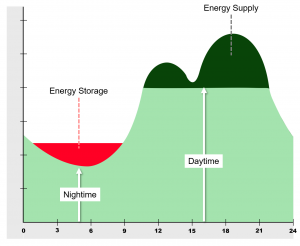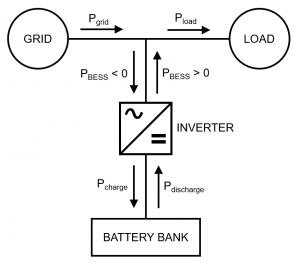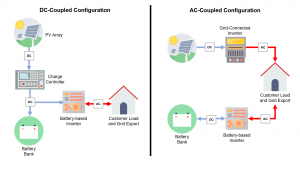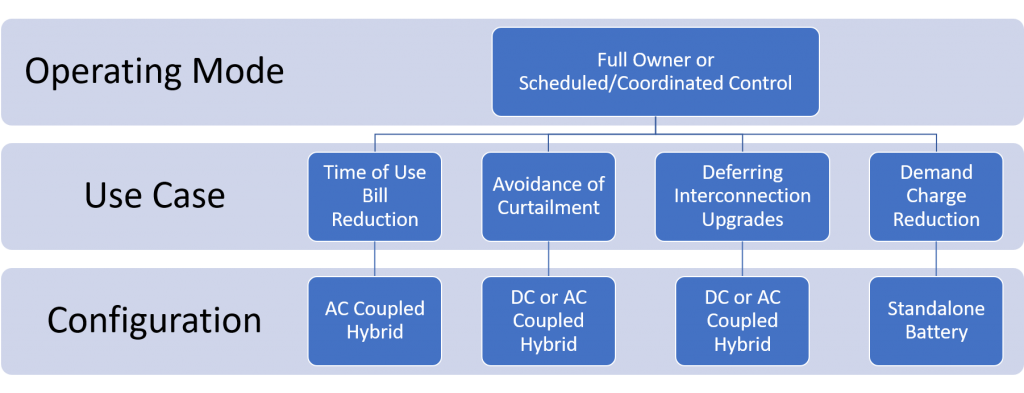Pterra was engaged by the New York State (NYS) Department of Public Service (DPS) to provide some insight into technical issues associated with battery energy storage systems (BESS) interconnecting into distribution feeders. This work was part of ongoing support Pterra is providing to the NYSDPS on NYS Standard Interconnection Requirements (SIR) procedures.
Inverter-based BESS
Just from the basic knowledge that electric demand cycles on a daily basis, one can intuit that storing extra energy when demand is low and releasing the energy when demand is high presents great potential benefits to the electric system. For example, intermittency in solar power on cloudy days can be a power quality concern but being able to absorb and pump power via storage devices in cadence with the cloud changes may help smooth out these issues. In distribution feeders, batteries may serve as dampers when the load is too low and peak-shavers when the demand is high, this combination leading to higher hosting capacity per circuit. Hence, there is a growing commercial interest in BESS applications.
The typical BESS installation for distribution systems is equipped with a converter — for DC-to-AC conversion when delivering power to the grid, i.e., “generating” or “discharging,” and for AC-to-DC when withdrawing power from the grid; i.e., “charging” or “acting as a load.” The BESS may be standalone, but more often it is applied in combination with a solar photovoltaic (PV) generation resource.
Use Cases, Configurations and Operations of BESS
To cover the wide variety of BESS applications, we classify them by use cases, configuration and operating mode.
- Use Case – this defines the goals for interconnecting the BESS to a distribution feeder without reference to method or control of operation
- Configuration – this defines the electrical schematic for interconnection including any associated protection and control equipment
- Operating Mode – this defines the rules for operating the BESS and who determines or implements them
Use Cases
As commercial devices, the primary “goal” of a BESS interconnecting to an existing distribution circuit is to add value. This may also mean that the installation produces a “profit,” however since that aspect is determined by the market rules and interconnection policy, we are assuming that any approach that adds value can make a profit. Furthermore, there is potential of someday selling distributed energy resource (DER) output to the wholesale market (for DER that is 2 MW or larger) per the NYISO DER Roadmap, which includes participation in the ancillary services markets as well (demand response, load following, operating reserve, back-up power, black start, etc.).
Use Cases depend on whether the interconnecting BESS is a standalone device or operates in combination with some other form of generation or load. Typical Use Cases are as follows:
-
- Standalone BESS Use Cases
- Demand Charge reduction – The BESS is used to level off peak demand to reduce demand charges on utility bills. Typically applied to community BESS for residential and small commercial customers.

- Energy Arbitrage – Facility “buys” energy when prices are low and stores in BESS, then “sells” energy when prices are high. Applicable to energy markets only where there are hourly price points. (This is not yet applicable in New York distribution systems but is a potential future state per NYISO’s DER Roadmap.)
- Back-up and Black Start service – BESS serves as secondary option for energy supply during emergency conditions such as loss of power or as part of power restoration following an outage. Applicable to customers that have power-critical loads or ride-through requirements.
- Capacity resource to meet peak load – BESS can be part of capacity resources that can be made available to meet peak demand forecasts. This is not often specifically applied to feeders but is more an option for utilities and system operators when developing capacity resource requirements.
- Utility Use – Because the reliability benefits or value from BESS are not limited to energy and capacity, utilities find specific applications for BESS for a variety of purposes, including, transient and long term voltage control (for flicker, sags, power factor correction), ramping power to flatten variations from fluctuating generation, stability of island grids, frequency control, load following, operating reserve, among others. As noted earlier, such “utility” services may, at some future time, attain commercial value associated with development of an ancillary services market.
- Demand Charge reduction – The BESS is used to level off peak demand to reduce demand charges on utility bills. Typically applied to community BESS for residential and small commercial customers.
- Hybrid BESS (BESS combined with another form of generation)
- Time of Use Bill reduction – Industrial customers with non-peaking self-generation can store energy with BESS and deliver during peak load hours to reduce the utility bill.
- Avoidance of Curtailment – DER interconnecting to a lightly loaded feeder, or where the penetration levels are already high, run the risk of curtailment. Adding a battery to the installation allows the option of storing the excess generation for delivery at a later time when the demand on the feeder is higher.
- Output balancing/smoothing – A combination of PV and battery, with their fast inverter controls, will have capability to provide a flatter power output in the seconds to milliseconds timeframe. This avoids issues with power quality and may also be used to extend the operating period of a standalone PV installation.
- Deferring interconnection upgrades – A PV project by itself may hit various technical levels that trigger associated upgrades. One such level is when the number of DER MW exceeds a certain percentage of the minimum load on a feeder. This may trigger islanding or ground fault overvoltage upgrades such as DTT (direct transfer trip protection) or reclosers. If the battery is configured to act as a load (charging mode) at the minimum load period, this may increase the allowable penetration level for PV enough to avoid the upgrade. The value of the Use Case may only be present for certain electrical configurations.
- Load Support BESS (BESS combined with customer load)
- Improve reliability and power quality of connected load – The BESS serves multiple roles specific to support of the connected load, including back-up supply, bill reduction, flicker and voltage sag mitigation, among others. The operation can be similar to large scale universal power supply (UPS). This is typically a “behind-the-meter” use case where the distribution utility does not actually receive any energy. However, because of potential outflow and islanding issues, the utility still has an interest in ensuring that appropriate protection and countermeasures are provided so as not to impact reliability and safety.
- Improve reliability and power quality of connected load – The BESS serves multiple roles specific to support of the connected load, including back-up supply, bill reduction, flicker and voltage sag mitigation, among others. The operation can be similar to large scale universal power supply (UPS). This is typically a “behind-the-meter” use case where the distribution utility does not actually receive any energy. However, because of potential outflow and islanding issues, the utility still has an interest in ensuring that appropriate protection and countermeasures are provided so as not to impact reliability and safety.
- Standalone BESS Use Cases
For consideration of the SIR, those Use Cases that presently do not have a market structure or policy to support them are excluded. Likewise, the energy arbitrage Use Case (1b) is excluded pending development of time of day or hourly pricing for sale and purchase of energy at the distribution level.
Configurations
The typical configuration for a standalone battery interconnecting to a distribution feeder for Use Case 1a includes a controller for AC/DC conversion. There can be a large variety of controllers with features such as ride-through, ramp control, and anti-islanding. These controllers are slightly different from those used for PV in that the firing allows for either power in or power out. For example, the converters may have four quadrant reactive control, instead of the typical two quadrant control; four quadrant means the controller can deliver or absorb reactive power when either charging or discharging power.
Hybrid configurations appear to be more common because the value streams for DER are more favorable to combining BESS with other types of generation. The figure below shows the hybrid configurations with PV and BESS. The coupling can be at the DC or at the AC level.
The BESS’s converter can support charging and discharging operations; while the PV or grid inverter is only for delivering power to the feeder. Furthermore, the BESS inverter can have either two or four quadrant reactive control. Additional features such as passive and active anti-islanding, voltage and frequency regulation and ride-through, ramp rate control, flicker control, peak shaving and other protection and optimization functions may also be included with the converter.
For interconnection purposes, the distinct features of the hybrids configurations are as follows:
- Capacity of interconnection – for the DC-coupled configuration, this is defined by the size of the BESS inverter but is binary two-way (charge or discharge); while for the AC-coupled configuration, there are two separate capacities, one for the PV inverter and the other for the BESS converter when either charging or discharging. Furthermore, the BESS inverter may have different peak capacities when charging and when discharging; this relates to the use of the distribution system during interconnection assessment.
- Operating periods –
- Market conditions usually determine when it is best to charge and to discharge the BESS. BESS charging is best done at off-peak hours when energy is presumably cheaper and more abundant, while avoiding peak hours when energy is less abundant and pricier. But excluding the arbitrage aspect, it still makes sense to charge at off-peak so that the stress on the distribution facilities is less, compared to peak hours when the BESS would add on to the peak demand and perhaps require additional capacity on the distribution system and/or the energy supply with higher real and reactive losses. A charging period or schedule may be developed between utility and developer that is enforced by contract or by direct supervisory intervention by the utility.
- Likewise, market conditions determine when it is best to discharge the BESS. For the DC coupled configuration, the capacity to simultaneously discharge the battery and deliver power from the PV is limited by the capacity of the battery converter; hence, the interconnection assessment is based on the capacity of the converter and not on the combined capacity of PV and battery. For the AC coupled configuration, the PV and BESS can operate independently and hence both can deliver power to the distribution system at the same time; hence, the interconnection assessment needs to be based on the individual capacity of the PV inverter and the BESS converter. However, BESS discharge periods or schedule may also be agreed upon between the utility and developer such as to avoid simultaneous injection of power from PV and BESS.
- Monitoring and control (M&C) – where applicable, M&C is applied mainly on the AC portion of the interconnection. The DC-coupled configuration will allow M&C of the net output of the hybrid, while the AC-coupled configuration allows separate M&C of the BESS and the associated generation.
Operating Modes
The manner by which a BESS is operated could have a significant impact on the interconnection requirements. Types of operating modes include:
- Full Owner control – the Owner of the installation determines when, how much and for how long the BESS operates based on the value stream of their Use Case. This would require that the utility and regulators have fully vetted the technical requirements for all possible conditions of operation.
- Scheduled Operation – The installation is operated according to a fixed schedule agreed upon with the interconnecting utility.
- Coordinated Operation – The Owner proposes a daily/weekly schedule of operation which is approved or revised by the interconnecting Utility, and is subject to change during emergency states.
- Full Utility control – the installation is completely controlled by the interconnecting Utility.
Although most of the Use Cases under study imply an operating mode with Full Owner Control, there are instances where Scheduled or Coordinated Operation may be implemented by agreement of the facility owner/operator and the interconnecting utility.
Selected Scenarios for BESS
Based on the previous discussion, the scenarios of BESS for interconnection under SIR considered in this initial investigation are specified in the diagram below.
Interconnection Issues
Reviewing interconnection requirements in other jurisdictions provides insight on the particular issues that the selected types of BESS may face. A summary of issues are as follows.
Bifurcated process – By default, where no specific interconnection process is provided for BESS, the BESS is evaluated separately as a load and as a generator; i.e., there are separate applications to interconnect the generator part and the load part. This can lead to inefficiencies and inaccuracy in the assessment.
As a single device, the BESS uses the capacity of the existing distribution system in binary mode; i.e., as either load or generator, but not both. The utilization of the distribution system circuits is not the sum of the generation and load modes but is bi-directional with different capacities at different times. The interconnection process needs to provide for this quite distinct characteristic of BESS.
The Use Cases for a standalone BESS suggest that it will not charge during peak load hours and not discharge during off peak hours. However, under the Full Owner operating mode, there is no specific restriction that prevents the facility from charging at peak and discharging at off peak hours. Hence for this operating mode, the interconnection assessment has to assume that the applying standalone BESS may contribute to peak load, and to maximum DER penetration under off-peak load conditions. If the applicant agrees to either Scheduled or Coordinated operating modes, then there may be basis to say that the facility will not add to the peak load since it will only charge during off peak hours, and likewise not contribute to feeder level DER penetration since it will discharge only during peak hours. Hence, based on this approach, the BESS has maximum potential impact under Full Owner mode and a mitigated impact under Scheduled or Coordinated mode. This requires a distinction between the operating modes during the interconnection assessment process, whereas, by default, lacking any provisions for Scheduled or Coordinated operations, the BESS is evaluated for maximum impact on the assumption of Full Owner control.
The unique system use characteristic of standalone BESS extends to Use Cases for hybrid configurations. The specific possibilities are as follows:
- The hybrid is designed as a DC-coupled configuration – In this case, the interconnection capacity is based on the size of the converter since this controls how much power is delivered to the distribution system, and also limits the power that may be drawn from the system. Using the hybrid’s converter capacity, operating mode and schedule, the interconnection evaluation follows the same procedure as a standalone BESS.
- The hybrid is designed as an AC-coupled configuration – In this case applicant has the option of filing as two separate interconnections with the generator evaluated under the non-BESS SIR process, while the BESS is evaluated as a standalone BESS. If the applicant is filing as a single interconnection, then the assessment may follow along these lines:
- For the charging portion, determine if application is for Full Owner or Scheduled/Coordinated operations. If Full Owner, the charging is assumed to be possible at peak hours. If Scheduled/Coordinated operating mode, determine the charging hours and evaluate peak BESS charging at those hours only.
- For the discharge portion, determine if for Full Owner or Scheduled/Coordinated operations. If Full Owner, the discharge is assumed to be possible at off peak hours and is combined with capacity of the associated generation. If Scheduled/Coordinated operating mode, determine the discharge hours. Evaluate discharge in combination with full output of associated generator at the specified hours only.
Potential Technical Impacts and Associated Benefits. Because of the use of converter technology, BESS may tend to be lumped together with solar and wind type generation. By default, inverter-based BESS are evaluated for the same technical impacts as solar and inverter-based wind. However, BESS has very distinct technical characteristics from the other forms of DER.
- For one, it is not intermittent. BESS output is not dependent on insolation levels, cloud cover, typical weather cycles or wind variations, hence it does not introduce the same level of voltage fluctuation (whether transient or longer term variations), frequency shift or stability implications.
- For another, BESS are schedulable such as to avoid times and conditions when the worst impacts may occur. Thus, BESS can discharge when system load is high, and charge when demand levels are at minimum. By this ability to schedule, BESS avoids situations where system capacity may be exceeded, in fact, it optimizes the use of existing facilities by adjusting the use of the system through scheduled charge and discharge. In one Use Case, it can help avoid system upgrades which a standalone generator may be required to implement.
- Finally, BESS are programmable such as to respond to certain conditions of frequency and voltage, loading or oscillation. For example, certain types of BESS converters may be equipped for four quadrant reactive control that can smooth out voltage fluctuations and increase power factor whether the BESS itself is in charge or discharge mode. Its ramp rate can be adjusted within certain ranges to damp out oscillations or flicker and smoothen the output of intermittent resources.
Although some level of assessment is still needed to comply with standards, the discharge impact of BESS tends to be much less than similar sized solar and inverter-based wind generation. Likewise, the charging impact of BESS is not similar to most customer loads in the distribution system. It is curtailable, or reschedulable, and can be considered non-firm in most situations.
Overall, the distribution system benefits from addition of BESS through its non-valued contributions such as voltage control, backup supply, damping and ramping features, among others. BESS has capability for fast power conditioning and in its natural operating mode will condition the power on the system it is connected to, for example, operating like a universal power supply, smoothing out voltage fluctuations and absorbing harmonics.
Metering, Monitoring and Control (MMC). Once again, due to lack of specific consideration for the uniqueness of the BESS, the tendency is to apply separate rules for the charging and discharge modes. This is likewise true for MMC. Two-way MMC tend to be split into one MMC for charging and another for discharge. Since the BESS cannot charge and discharge at the same time, it is only necessary to have one MMC, but one capable of distinguishing between charge and discharge modes.
Establishing an Interconnection Standard
The NYS DPS through its Interconnection Technical Working Group (ITWG), as well as the parallel policy working group, the IPWG, are working to incorporate interconnection standards and guidelines for integrating BESS in distribution systems. (Note that New York State has a storage goal of 1,500 MW by 2025, and a 2030 energy storage deployment target of up to 3,000 MW. For details, follow this link.)
One of the initial guidelines addresses BESS that are being added to PV projects whose interconnection applications are still under process. (The draft of the guideline can be found on this link.) The specific technical issues addressed in the guideline are:
- For DC coupled BESS and PV with no export of the BESS output to the grid, the BESS will not affect the interconnection assessment of the PV project, but the utility can review the configuration of the BESS.
- New assessments are required if the converter is changed or if some export of BESS output in combination with the PV is planned. In the former case, a test for anti-islanding is applied. In the latter case, the export capacity of the installation, termed as the “maximum export window”, may be revised by the applicant and the assessment based on this new value of export window. Scheduling of the charge and discharge states determines if any technical impact is anticipated.
- If there are transformer and grounding changes associated with the addition of the BESS, a grounding assessment is conducted.
- For AC coupled BESS, a detailed assessment will be required.
As the market and industry structures, as well as regulations and rules, evolve for BESS, the technical issues may likewise change. The impact of BESS generally derives from its usage and operating mode and so as these aspects change, we may see other issues associated with BESS impacts requiring attention. However, significant steps have been made towards making BESS a viable part of distribution systems, and yet, even more significant changes are needed to better utilize this important type of energy resource.



